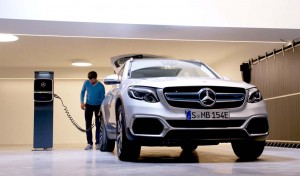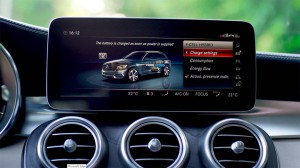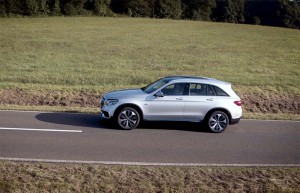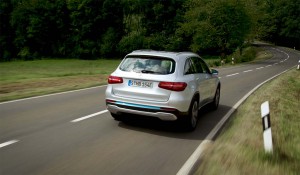Like many other European automakers, Mercedes-Benz is making a substantive push toward electrifying its line-up in the wake of multiple problems with diesel engines.
Much of Mercedes efforts have focused on straight battery-electrics, the automaker is looking at other zero-emission alternatives. That effort has culminated in the GLC F-Cell, a fuel-cell/plug-in hybrid the company debuted at the Frankfurt Motor Show
One of the major advantages of this option is that the interplay between battery and fuel cell, along with short refueling times, is everyday practicality and long-distance motoring. With 4.4 kg of hydrogen on board, the preproduction model produces enough energy for a range of up to 437 km or about 280 miles in the NEDC.
F-Cell drivers will also benefit from a range of up to 49 km or 31 miles in the NEDC thanks to the large lithium-ion battery.

The new GLC F-Cell needs 1.5 hours to recharge spent batteries and just minutes for the hydrogen fuel cells.
(Mercedes to join hydrogen car club. Click Here for the story.)
An output of 147 kW or 197 horsepower guarantees both dynamic performance and locally zero emissions driving pleasure. In unveiling the preproduction vehicles of the Mercedes-Benz GLC F-Cell, Daimler is taking another important step as part of its systematic “CASE” strategy.
The CASE strategy centers on connected vehicles, autonomous and self-driving vehicles, shared vehicles and electrified vehicles, which is really the move toward meeting the mobility needs of consumers in the future.
Between now and 2022, Daimler intends to bring out 10 battery-electric vehicles, globally, with the GLC F-Cell representing an important landmark. The new hybrid is part of the company’s EQ electric-only line-up.
“Our many years of experience with fuel-cell technology pay dividends in the new GLC F- Cell: its long electric range, short refueling times and everyday practicality of an SUV will make it the perfect vehicle,” said Ola Källenius, member of the Board of Management of Daimler AG, responsible for Group Research & Mercedes-Benz Cars Development.
(Click Here for more about the Smart Vision EQ Concept.)
“This is made possible by the compact construction of our fuel-cell system. Another genuine world first is the combination with a large additional lithium-ion battery, which can be conveniently charged using plug-in technology.”
The new model is really an upgraded version of Daimler’s B-Class F-Cell, which has been on the market since 2010. However, with a variety of tweaks the overall drive system offers around 40% more output. The fuel-cell system is around 30% more compact than before and can for the first time be housed entirely in the engine compartment, and the use of platinum in the fuel cell has been reduced by 90%.

The GLC F-Cell features easy-to-read gauges to check vital information about the operation of the vehicle.
While the hydrogen tanks can be refilled quickly, the batteries need 1.5 hours to recharge if completely expended, Mercedes notes. Aside from that, it aims to be handled like a regular vehicle, including offering three different drive programs ECO, COMFORT and SPORT.
ECO is optimized for low consumption. COMFORT is geared not only for comfort, but also provides ideal climate control. SPORT optimizes the hybrid powertrain for sporty performance.
(Mercedes Concept EQ A teases long-range compact EV. For the story, Click Here.)
Like all Mercedes-Benz vehicles, the F-Cell features a variety of active and passive safety technologies, including Active Distance Assist DISTRONIC, Lane Tracking Package with Blind Spot Assist and Active Lane Keeping Assist, Parking Package with 360-degree camera or COMAND with traffic sign recognition.


